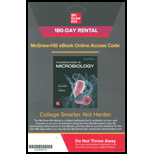
FOUND.IN MICROBIOLOGY-ACCESS >CUSTOM<
10th Edition
ISBN: 9781266032264
Author: TALARO
Publisher: MCG CUSTOM
expand_more
expand_more
format_list_bulleted
Concept explainers
Question
Chapter 1.2, Problem 5ELO
Summary Introduction
To determine:
- The details of cellular makeup of microorganisms.
- The size range of microorganisms.
- The ways in which viruses are different from cellular microbes.
Introduction:
The world is full of with different kinds of organisms, each with different and unique features and attributes. Some of these organisms are invisible to the naked eye and can only be visualized with the help of a microscope. Such organisms are called microorganisms. Even though all microorganisms are invisible to the naked eye, some microorganisms are much smaller than the rest. Also, different types of microorganisms have different characteristics that can only be studied upon magnification.
Expert Solution & Answer
Want to see the full answer?
Check out a sample textbook solution
Students have asked these similar questions
Give a brief account of viruses with
respect to their structure and nature
of genetic material.
Also name four common viral diseases.
differentiate between a viral infection and a bacterial infection?
Explain the unique characteristics of viruses compared toliving cells.
Chapter 1 Solutions
FOUND.IN MICROBIOLOGY-ACCESS >CUSTOM<
Ch. 1.1 - Define microbiology and microorganisms, and...Ch. 1.1 - Name and define the primary fields included in...Ch. 1.1 - Define what is meant by the term microorganism and...Ch. 1.1 - Describe five different ways in which humans...Ch. 1.2 - Prob. 3ELOCh. 1.2 - Prob. 4ELOCh. 1.2 - Prob. 5ELOCh. 1.2 - Prob. 3CYPCh. 1.2 - Observe figure 1.3 and place the microbes pictured...Ch. 1.2 - Prob. 5CYP
Ch. 1.2 - Prob. 6CYPCh. 1.3 - Prob. 6ELOCh. 1.3 - Describe several ways the beneficial qualities of...Ch. 1.4 - Prob. 7ELOCh. 1.4 - Prob. 8ELOCh. 1.4 - Prob. 8CYPCh. 1.4 - Prob. 9CYPCh. 1.5 - Prob. 9ELOCh. 1.5 - Prob. 10ELOCh. 1.5 - Prob. 10CYPCh. 1.5 - Prob. 11CYPCh. 1.5 - Prob. 12CYPCh. 1.5 - Why was the abandonment of the spontaneous...Ch. 1.6 - Define taxonomy and its supporting terms...Ch. 1.6 - Prob. 12ELOCh. 1.6 - Describe the goals of nomenclature and how the...Ch. 1.6 - Prob. 14CYPCh. 1.6 - Prob. 15CYPCh. 1.6 - Explain the binomial system of nomenclature and...Ch. 1.6 - Explain sonic of the benefits of using scientific...Ch. 1.7 - Prob. 14ELOCh. 1.7 - Explain the concepts behind the organization of...Ch. 1.7 - Explain the bases foe classification, taxonomy,...Ch. 1.7 - Prob. 17ELOCh. 1.7 - Prob. 18CYPCh. 1.7 - Prob. 19CYPCh. 1.7 - Prob. 20CYPCh. 1.7 - Archaea are often found living in extreme...Ch. 1.7 - Compare the domain system with the five-kingdom...Ch. 1.L1 - Which of the following is not considered a...Ch. 1.L1 - An area of microbiology that is concerned with the...Ch. 1.L1 - Which process involves the deliberate alteration...Ch. 1.L1 - A prominent difference between prokaryotic and...Ch. 1.L1 - Prob. 5MCQCh. 1.L1 - Abiogenesis refers to the a. spontaneous...Ch. 1.L1 - Prob. 7MCQCh. 1.L1 - Prob. 8MCQCh. 1.L1 - Which scientist is most responsible for finally...Ch. 1.L1 - Prob. 10MCQCh. 1.L1 - Prob. 11MCQCh. 1.L1 - Prob. 12MCQCh. 1.L1 - Prob. 13MCQCh. 1.L1 - Prob. 14MCQCh. 1.L1 - Prob. 15MCQCh. 1.L1 - Prob. 16MCQCh. 1.L1 - Many of the bacteria in Lake Whillans derive...Ch. 1.L1 - Prob. 2CSRCh. 1.L1 - Prob. 3CSRCh. 1.L1 - What does it mean to say microbes are ubiquitous?Ch. 1.L1 - Prob. 2WCCh. 1.L1 - What events, discoveries, or inventions were...Ch. 1.L1 - Prob. 4WCCh. 1.L1 - Explain how microbes arc classified into groups...Ch. 1.L1 - Prob. 6WCCh. 1.L2 - What do you suppose the world would be like if...Ch. 1.L2 - How would you describe the types of scientific...Ch. 1.L2 - Give the technical name of a microbiologist who...Ch. 1.L2 - Name the six most common infectious agents on...Ch. 1.L2 - Prob. 5CTCh. 1.L2 - Prob. 6CTCh. 1.L2 - Construct the scientific name of a newly...Ch. 1.L2 - Prob. 1VC
Knowledge Booster
Learn more about
Need a deep-dive on the concept behind this application? Look no further. Learn more about this topic, biology and related others by exploring similar questions and additional content below.Similar questions
- Describe the unique characteristics of viruses.arrow_forwardDescribe the Position of Viruses in the Biological Spectrum.arrow_forwarda. Since viruses lack metabolic enzymes, how can they synthesize necessary components? b. Name some enzymes that viruses may have for invading and completing their cycles.arrow_forward
- Describe the four general mechanisms by which microorganisms cause disease.arrow_forwardDescribe the characteristics of infectious diseases, including the course of disease, duration of symptoms, and distribution of the pathogen.arrow_forwardWhat are the characteristics of bacteria? What are the characteristics of viruses? Be specific in describing the size, structure, shape, and reproductive cycle of each.arrow_forward
- Define the term pathogen. Using MRSA, NOROVIRUS, ATHLETES FOOT and MALARIA as examples, identify the microorganisms (causal agent) involved in each disease. Provide some information on the microorganism for each disease e.g. structure Discuss 3 routes of entry that disease causing organisms use to enter the body.arrow_forwardExplain how specialized structures (e.g., spore, capsule, fimbriae, or flagella) enable a microbe to survive in a given environment or contribute to pathogenesis.arrow_forwardExplain the Virus species in terms of monophyletic group of viruses whose properties differ from those of other species by multiple criteria: Host range, cell and tissue tropism, pathogenicity, vector specificity, antigenicity, and degree of relatedness of their genomes or genes.arrow_forward
arrow_back_ios
SEE MORE QUESTIONS
arrow_forward_ios
Recommended textbooks for you
